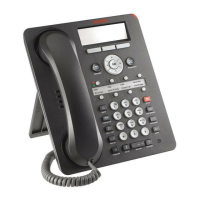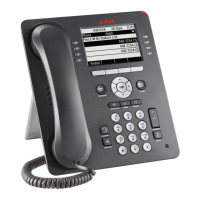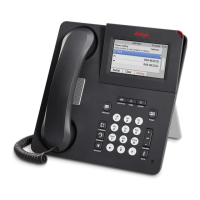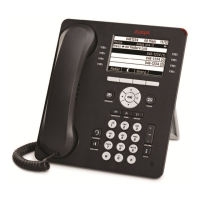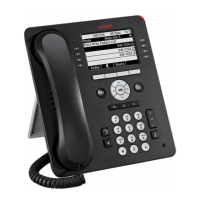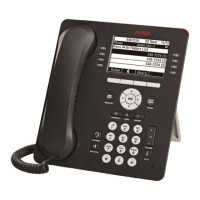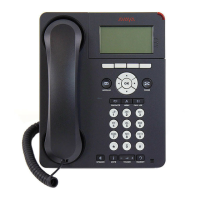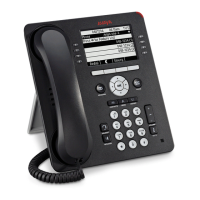







Do you have a question about the Avaya one-X and is the answer not in the manual?
Provides an overview of features, functionality, and differences between 9608 and 9611G models.
Describes how administrators send messages to the phone, including text and audio alerts.
Instructions on how to attach and adjust the telephone stand for optimal positioning.
Accesses settings for calls, buttons, display, language, and advanced features.
Accesses web apps, network details, and software information.
Allows users to sign off the phone, protecting settings or enabling other users.
Adjust call display, timers, redial, speed dial, and auto-answer settings.
Customize favorites, display, audio, language, and integrate applications.
Automatically display the Phone screen when placing or receiving calls.
Enable call timer display and choose redial methods.
Configure flashing LEDs for alerts and set the default audio path for calls.
Choose dialing methods and assign speed dial numbers to contacts.
Build favorite lists and customize button labels for features and extensions.
Adjust screen brightness/contrast and edit button labels on modules.
Select ring tones and assign specific tones for call pickup.
Set visual and/or audible alerts for incoming calls.
Customize logos, button clicks, and error tones.
Adjust screen width and select display language.
Set time format and configure AGC for audio devices.
Configure credentials and preferences for integrating Exchange calendar.
Methods to answer or ignore incoming calls using handset, speaker, or headset.
Temporarily suspend calls, mute audio, and initiate call transfers.
Instructions for making emergency calls, including failover considerations.
Use redial, speed dial, and autodial for efficient call initiation.
Use edit dialing and call contacts from the list.
Initiate calls using call history or 'click to dial' links.
Redirect all calls or forward to a specific number.
Initiate conference calls and add participants.
Manage conference calls by holding, dropping, or resuming.
Answer or join calls on bridged lines.
Make outgoing calls, exclude others, and transfer bridged calls to VM.
Find contacts using the dialpad and search functionality.
Perform extended searches and view detailed contact information.
Modify contact information and remove contacts from the list.
Access and view details of answered, outgoing, and missed calls.
Save call history entries as contacts and delete history records.
Clear all history entries and disable call history logging features.
Access voicemail by pressing Message button and following prompts.
Navigating to and using the Features menu on the phone.
Check extension status and customize autodial number labels.
Set up auto call back for busy lines and make auto intercom calls.
Forward calls when busy/unanswered and block extension display.
Hold calls to answer elsewhere and retrieve parked calls.
Answer calls from other extensions or pickup groups.
Make intercom calls and trace malicious calls.
Record calls and make priority calls with special alerts.
Interrupt calls with whisper page and configure simultaneous ringing.
Use buttons, softkeys, and links to browse web content.
Set appointment reminders and review calendar entries.
Log in to your telephone extension using username and password.
Log out of your telephone extension, saving settings.
Provides an overview of features, functionality, and differences between 9608 and 9611G models.
Describes how administrators send messages to the phone, including text and audio alerts.
Instructions on how to attach and adjust the telephone stand for optimal positioning.
Accesses settings for calls, buttons, display, language, and advanced features.
Accesses web apps, network details, and software information.
Allows users to sign off the phone, protecting settings or enabling other users.
Adjust call display, timers, redial, speed dial, and auto-answer settings.
Customize favorites, display, audio, language, and integrate applications.
Automatically display the Phone screen when placing or receiving calls.
Enable call timer display and choose redial methods.
Configure flashing LEDs for alerts and set the default audio path for calls.
Choose dialing methods and assign speed dial numbers to contacts.
Build favorite lists and customize button labels for features and extensions.
Adjust screen brightness/contrast and edit button labels on modules.
Select ring tones and assign specific tones for call pickup.
Set visual and/or audible alerts for incoming calls.
Customize logos, button clicks, and error tones.
Adjust screen width and select display language.
Set time format and configure AGC for audio devices.
Configure credentials and preferences for integrating Exchange calendar.
Methods to answer or ignore incoming calls using handset, speaker, or headset.
Temporarily suspend calls, mute audio, and initiate call transfers.
Instructions for making emergency calls, including failover considerations.
Use redial, speed dial, and autodial for efficient call initiation.
Use edit dialing and call contacts from the list.
Initiate calls using call history or 'click to dial' links.
Redirect all calls or forward to a specific number.
Initiate conference calls and add participants.
Manage conference calls by holding, dropping, or resuming.
Answer or join calls on bridged lines.
Make outgoing calls, exclude others, and transfer bridged calls to VM.
Find contacts using the dialpad and search functionality.
Perform extended searches and view detailed contact information.
Modify contact information and remove contacts from the list.
Access and view details of answered, outgoing, and missed calls.
Save call history entries as contacts and delete history records.
Clear all history entries and disable call history logging features.
Access voicemail by pressing Message button and following prompts.
Navigating to and using the Features menu on the phone.
Check extension status and customize autodial number labels.
Set up auto call back for busy lines and make auto intercom calls.
Forward calls when busy/unanswered and block extension display.
Hold calls to answer elsewhere and retrieve parked calls.
Answer calls from other extensions or pickup groups.
Make intercom calls and trace malicious calls.
Record calls and make priority calls with special alerts.
Interrupt calls with whisper page and configure simultaneous ringing.
Use buttons, softkeys, and links to browse web content.
Set appointment reminders and review calendar entries.
Log in to your telephone extension using username and password.
Log out of your telephone extension, saving settings.
| Category | IP Phone |
|---|---|
| Brand | Avaya |
| Model | one-X |
| Supported Protocols | SIP, H.323 |
| Volume Controls | Yes |
| Speakerphone | Yes |
| Wall Mountable | Yes |
| Power over Ethernet | Yes |
| Headset Port | Yes |
| Ethernet Ports | 2 |
